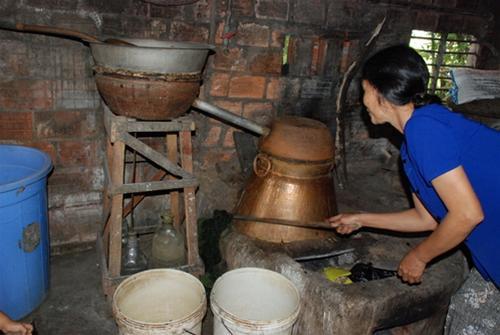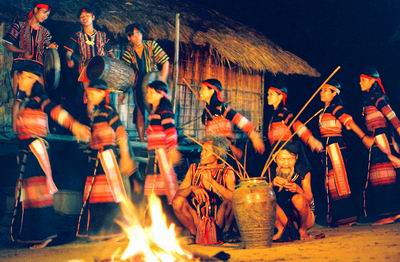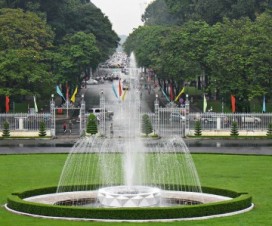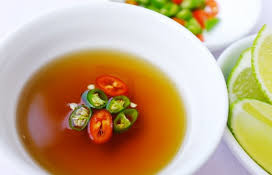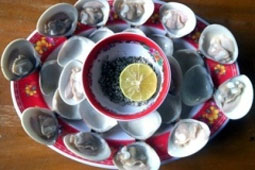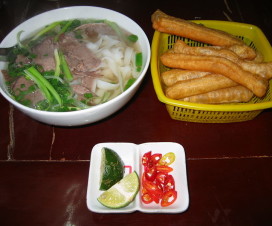Mot! Hai! Ba! Do! (One! Two! Three! Drink!), shout my friends and I as we lean forward to sip sweet, golden rice wine in unison through long bamboo straws in Phan Thiet City. Between rounds we tear off bits of salted, dried squid dipped in a blend of sour tamarind and soy sauce; unwrap pickled pork in banana leaf; and slurp the semi-formed fetus from hard boiled quail eggs. These and other essential drinking snacks are appropriately called moi, or “fish bait.”
When I go out drinking with other men (it’s not yet acceptable for Vietnamese girls to drink alcohol), or di nhau (go on a drinking session), it’s essential that we all drink equal portions. Unlike in the north, we pass around a communal glass here in the south. Despite the potency (40% ABV), I can’t stop anxiously recalling the high rates of hepatitis and TB here in Binh thuan Province.
There are three major kinds of rice wine in Vietnam: the conventional distilled variety known as ruou gao (literally “rice alcohol”), wine brewed in large ceramic jars called ruou can (party wine), and distilled alcohol infused with plants and animals, known as ruou thuoc (medicine wine).
Ruou gao or ruou de (plain rice alcohol)
Distilled rice wine is known as ruou gao in the north and ruou de in the south. Most rice wine is made in small home distilleries using either normal or sticky rice. The white rice is first cooked and mashed, then water and yeast is added before the mixture is left to ferment. The resulting broth is eventually distilled to produce alcohol.
Consumption of Vietnamese rice wine has serious risks. Toxins leached into the alcohol from the still, or small amounts of rubbing alcohol (added intentionally to improve appearance) often cause blindness or even death.
In Lam Dong Province, traditional home distillery owners also raise hogs. The rice mash that is left over after distillation (pictured above) is happily consumed by the animals, which as a result, spend most of their time lying around intoxicated and quickly fatten-up.
Cham men drinking ruou can in Mui Ne, Binh Thuan Province, procured from their Raglai neighbors (a sister tribe residing in the mountains).
Ruou can (party wine)
Ruou can is my personal favorite, and traditionally made by Vietnam’s hilltribe minorities for special occasions like weddings and the New Year festival. Ruou can is very different from ruou gao because it is not distilled. Instead, brown or black sticky rice, herbs, tree bark, and other natural flavorings are packed into a large ceramic jar and allowed to ferment for at least couple of weeks.
Just before the party, liquid is added to the moist mixture — often coconut juice, soda water or beer — and allowed to sit for an hour or more. For extended drinking sessions, the full volume of liquid may be replenished twice. The resulting beverage, drunk through long bamboo straws, is sweet and potent with a complex flavor. The pallet spectrum includes coffee, honey, chocolate, anise, cloves and cinnamon, all depending upon the unique ingredients added by each hilltribe.
Superstition plays a part in the production of ruou thuoc. “Traditionally, a prized wine should be buried at the northeast corner of a three-way crossroads and left underground for 100 days to obtain optimum balance with nature,” says Ha Le Hung, pictured here with snake wine — a variety of ruou thuoc at the Forest Restaurant in Mui Ne, Binh Thuan Province.
Ruou thuoc (medicine wine)
“There are more than 100 kinds of ruou thuoc,” says Ha Le Hung, a local expert and owner of the Forest Restaurant in Mui Ne. “Each is prescribed for a different ailment — one for old men with back problems, another for women after childbirth, one to aid digestion or circulation and so on.” Enhanced male sexual virility is a dominant, recurring theme.
Ruou thuoc, or medicine wine, is a potent form of distilled rice alcohol infused with herbs, fruits, spices, and wild animals like snakes, geckos and seahorses. Many endangered species are poached for use in ruou thuoc, including bears for their bile, and dear for antlers, hooves and fetuses. Some herbal varieties are indeed tasty and may have health benefits derived from traditional Chinese medicine. I find others taste horrid and most certainly provide only superstition-induced placebo effects… not that I need to boost my own virility, of course.
A broad selection of ruou thuoc, with whole geckos, snakes, sea horses, deer legs, deer fetus, birds, and baby monkeys is on display at a Buon Ma Thuat, Dak Lak Province rice wine shop. Single shots can be purchased with the addition of a beating cobra heart, spleen, or topped off with a teaspoon of warm cobra blood.
Ruou Thuoc, particularly ruou ran (snake wine), is a popular souvenir item, despite being illegal to import in some countries. These souvenir bottles on display at a Saigon shop should never be consumed, as the rice alcohol is often “enhanced” with rubbing alcohol or formaldehyde.
Source: CNNgo

